Related Research Articles

Lantana ( ) is a genus of about 150 species of perennial flowering plants in the verbena family, Verbenaceae. They are native to tropical regions of the Americas and Africa but exist as an introduced species in numerous areas, especially in the Australian-Pacific region, South and Northeastern part of India. The genus includes both herbaceous plants and shrubs growing to 0.5–2 m (1.6–6.6 ft) tall. Their common names are shrub verbenas or lantanas. The generic name originated in Late Latin, where it refers to the unrelated Viburnum lantana.

The Pterophoridae or plume moths are a family of Lepidoptera with unusually modified wings. Though they belong to the Apoditrysia like the larger moths and the butterflies, unlike these they are tiny and were formerly included among the assemblage called "microlepidoptera".

Lantana camara is a species of flowering plant within the verbena family (Verbenaceae), native to the American tropics. Other common names of L. camara include big-sage (Malaysia), wild-sage, red-sage, white-sage (Caribbean), korsu wiri or korsoe wiwiri (Suriname), tickberry, West Indian lantana, umbelanterna, putus in Bengal and Gu Phool in Assam, India.

Lantana montevidensis is a species of lantana known by many common names, such as: trailing lantana, weeping lantana, creeping lantana, small lantana, purple lantana or trailing shrubverbena.

The geranium plume moth is a moth of the family Pterophoridae. It is found in western Africa, Madagascar, India, Sri Lanka, Thailand, Japan, the New Hebrides and Central and South America, as well as Australia, where it has been recorded from Cape York to central New South Wales. It is also present in the United States, where it has been recorded from Florida, as well as Mississippi.

Lantanophaga pusillidactyla, the lantana plume moth, is a moth of the family Pterophoridae. It is native to the southern United States, Mexico, the Caribbean and South America. It was introduced to Australia accidentally in 1936 and is now found from Sydney to Cairns along the coast. It has also been introduced to Hawaii in 1902, Pohnpei in 1948 and Palau in 1960 for biological control. It has since been recorded from Yap in 1987–1988 and is now distributed on all islands of the Mariana and Caroline Islands where the host plant is found, except Aguijan.
Notioplusia illustrata, the notioplusia moth, is a moth of the family Noctuidae first described by Achille Guenée in 1852. It is native to Saint Kitts, the Greater Antilles, Florida, Mexico, Panama and South America. It was introduced to Australia and South Africa.

Lepidochrysops patricia, the patrician blue, is a butterfly of the family Lycaenidae. It is found in South Africa, from the Western Cape to the Eastern Cape and to KwaZulu-Natal, the Free State, Gauteng, Mpumalanga, Limpopo, the North West and the Northern Cape.
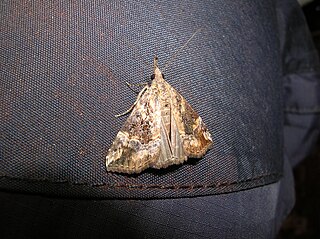
Hypena laceratalis, the lantana defoliator, is a moth of the family Erebidae. It was first described by Francis Walker in 1859. It is native to Africa to Yemen and India, but was deliberately introduced to Australia via Hawaii in 1965 to control the weed Lantana camara.
Diastema tigris, the lantana moth or lantana control moth, is a moth of the family Noctuidae. The species was first described by Achille Guenée in 1852. It is endemic to the US states of Florida and Texas, but has been introduced in Zambia, Australia, Micronesia, Fiji, Hawaii, Ghana, St. Helena, Tanzania, Uganda and Mauritius. as biological control of Lantana camara.

Crocidosema lantana, the lantana flower-cluster moth or lantana tortricid moth, is a moth of the family Tortricidae. It was first described by August Busck in 1910. It is native to Mexico and the southern United States, but was introduced to Hawaii in 1902, Australia in 1914 and the Caroline Islands in 1948 and 1949 to aid in the control of Lantana weeds. It has also been recorded from Yunnan, China and in Sri Lanka.

Lithocolletinae is a subfamily of insects in the moth family Gracillariidae. It is distributed worldwide, with most species in temperate regions.
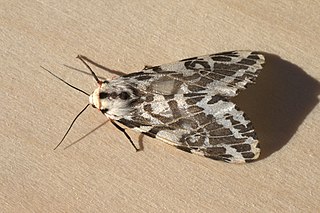
Ardices glatignyi, the black and white tiger moth, is a moth in the family Erebidae that is found in Australia. The species was first described by Le Guillou in 1841. Formerly included in Spilosoma, but later generic status of Ardices was proved by Vladimir Viktorovitch Dubatolov (2005). The larvae are polyphagous, and are known to feed on Lantana camara, Acanthus mollis, and Tradescantia albiflora.

Leptophobia aripa, the common green-eyed white or mountain white, is a butterfly in the family Pieridae. It is native to Mexico, Central America and South America, but strays may be found as far north as southern Texas.
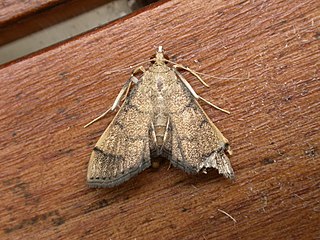
Omiodes indicata, the bean-leaf webworm moth or soybean leaf folder, is a species of moth of the family Crambidae. It is found from Florida to Texas, the West Indies and Mexico to South America, Cameroon, the Comoros, the Democratic Republic of Congo, La Réunion, Madagascar, Mauritius, Nigeria, Saudi Arabia, the Seychelles, South Africa, India, Borneo and Australia (Queensland).
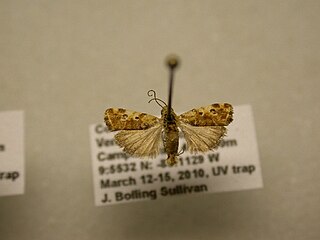
Spragueia perstructana is a moth of the family Noctuidae first described by Francis Walker in 1865. It is found from the United States, south to the Caribbean and Central America, including Costa Rica.
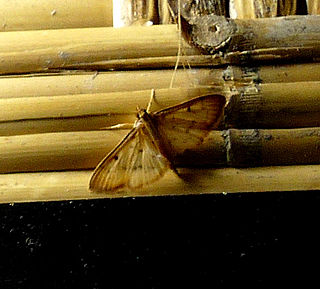
Herpetogramma basalis is a species of moth in the family Crambidae. It is found on the Canary Islands and in Japan, China, Australia, Sri Lanka, India, Indonesia, La Réunion, South Africa, and Mali.
Amorbia laterculana is a species of moth of the family Tortricidae. It is found from Guatemala to Sinaloa in Mexico, where it is found at altitudes between 1,700 and 2,800 meters.
Archips mimicus is a species of moth of the family Tortricidae first described by Lord Walsingham in 1900. It is found in India, Sri Lanka and Malaysia. In the Catalogue of Life, the species is considered as a synonym of Archips dispilana.
Argyrotaenia sphaleropa is a species of moth of the family Tortricidae. It is found in South America, where it has been recorded from Colombia, Bolivia, Brazil, Peru, Uruguay and Argentina.
References
- ↑ "Scientific name search". The Global Lepidoptera Names Index. Natural History Museum, London.
- ↑ Savela, Markku. "Ectaga garcia Becker, 1994". Lepidoptera and Some Other Life Forms. Retrieved January 10, 2018.
- ↑ Lepidoptera Larvae of Australia
| This article on a moth of the subfamily Depressariinae is a stub. You can help Wikipedia by expanding it. |